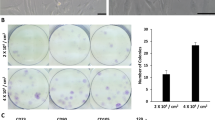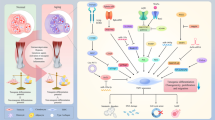Abstract
Tendon stem cells (TSCs), recently identified as tendon cells, play an important role in maintaining the homeostasis of tendon tissue. Age-related decrease in the function of TSCs has been reported. Recent reports demonstrated that hypoxic condition is advantageous for efficient expansion of TSCs. Moreover, the impaired function of aged stem cells could be modulated by exposing them to a young environment. Therefore, we investigated the effects of hypoxic-conditioned culture medium (HCCM) from young TSCs on the proliferation, migration, senescence, and tenocyte phenotype of aged TSCs. TSCs were isolated, and the conditioned medium was collected. There were 4 groups: young TSCs, aged TSCs, aged TSCs + aged HCCM, and aged TSCs + young HCCM. The proliferative capacity, migration, β-galactosidase activity, and tenogenic differentiation potential of TSCs were assessed. Our results showed that HCCM enhanced the proliferation and migration potential of aged TSCs. Moreover, the senescence-associated β-galactosidase activity of aged TSCs was decreased by young HCCM. After being cultured in the young HCCM, the expressions of tenocyte-related genes in aged TSCs were significantly enhanced. Together, results of this study indicate that HCCM from young TSCs may represent an effective strategy to improve the impaired function of aged TSCs.




Similar content being viewed by others
References
Bjornsson, H. C., Norlin, R., Johansson, K., & Adolfsson, L. E. (2011). The influence of age, delay of repair, and tendon involvement in acute rotator cuff tears: structural and clinical outcomes after repair of 42 shoulders. Acta Orthopaedica, 82, 187–192.
Dudhia, J., Scott, C. M., Draper, E. R., Heinegard, D., Pitsillides, A. A., & Smith, R. K. (2007). Aging enhances a mechanically induced reduction in tendon strength by an active process involving matrix metalloproteinase activity. Aging Cell, 6, 547–556.
Tsai, W. C., Chang, H. N., Yu, T. Y., Chien, C. H., Fu, L. F., Liang, F. C., et al. (2011). Decreased proliferation of aging tenocytes is associated with down-regulation of cellular senescence-inhibited gene and up-regulation of p27. Journal of Orthopaedic Research: Official Publication of the Orthopaedic Research Society, 29, 1598–1603.
Bi, Y., Ehirchiou, D., Kilts, T. M., Inkson, C. A., Embree, M. C., Sonoyama, W., et al. (2007). Identification of tendon stem/progenitor cells and the role of the extracellular matrix in their niche. Nature Medicine, 13, 1219–1227.
Zhou, Z., Akinbiyi, T., Xu, L., Ramcharan, M., Leong, D. J., Ros, S. J., et al. (2010). Tendon-derived stem/progenitor cell aging: defective self-renewal and altered fate. Aging Cell, 9, 911–915.
Barboni, B., Curini, V., Russo, V., Mauro, A., Di Giacinto, O., Marchisio, M., et al. (2012). Indirect co-culture with tendons or tenocytes can program amniotic epithelial cells towards stepwise tenogenic differentiation. PLoS ONE, 7, e30974.
Dunkman, A. A., Buckley, M. R., Mienaltowski, M. J., Adams, S. M., Thomas, S. J., Satchell, L., et al. (2013). Decorin expression is important for age-related changes in tendon structure and mechanical properties. Matrix Biology: Journal of the International Society for Matrix Biology, 32, 3–13.
Yu, T. Y., Pang, J. H., Wu, K. P., Chen, M. J., Chen, C. H., & Tsai, W. C. (2013). Aging is associated with increased activities of matrix metalloproteinase-2 and -9 in tenocytes. BMC Musculoskeletal Disorders, 14, 2.
Lee, W. Y., Lui, P. P., & Rui, Y. F. (2012). Hypoxia-mediated efficient expansion of human tendon-derived stem cells in vitro. Tissue Engineering Part A, 18, 484–498.
Zhang, J., & Wang, J. H. (2013). Human tendon stem cells better maintain their stemness in hypoxic culture conditions. PLoS ONE, 8, e61424.
Zheng, W., Wang, S., Ma, D., Tang, L., Duan, Y., & Jin, Y. (2009). Loss of proliferation and differentiation capacity of aged human periodontal ligament stem cells and rejuvenation by exposure to the young extrinsic environment. Tissue Engineering Part A, 15, 2363–2371.
Liang, C. C., Park, A. Y., & Guan, J. L. (2007). In vitro scratch assay: A convenient and inexpensive method for analysis of cell migration in vitro. Nature Protocols, 2, 329–333.
Klatte-Schulz, F., Pauly, S., Scheibel, M., Greiner, S., Gerhardt, C., Schmidmaier, G., et al. (2012). Influence of age on the cell biological characteristics and the stimulation potential of male human tenocyte-like cells. European Cells and Materials, 24, 74–89.
Chang, H. N., Pang, J. H., Chen, C. P., Ko, P. C., Lin, M. S., Tsai, W. C., et al. (2012). The effect of aging on migration, proliferation, and collagen expression of tenocytes in response to ciprofloxacin. Journal of Orthopaedic Research: Official Publication of the Orthopaedic Research Society, 30, 764–768.
Almekinders, L. C., & Deol, G. (1999). The effects of aging, antiinflammatory drugs, and ultrasound on the in vitro response of tendon tissue. The American Journal of Sports Medicine, 27, 417–421.
Dimri, G. P., Lee, X., Basile, G., Acosta, M., Scott, G., Roskelley, C., et al. (1995). A biomarker that identifies senescent human cells in culture and in aging skin in vivo. Proceedings of the National Academy of Sciences of the United States of America, 92, 9363–9367.
Dos Santos, F., Andrade, P. Z., Boura, J. S., Abecasis, M. M., da Silva, C. L., & Cabral, J. M. (2010). Ex vivo expansion of human mesenchymal stem cells: A more effective cell proliferation kinetics and metabolism under hypoxia. Journal of cellular physiology, 223, 27–35.
Tsai, C. C., Chen, Y. J., Yew, T. L., Chen, L. L., Wang, J. Y., Chiu, C. H., et al. (2011). Hypoxia inhibits senescence and maintains mesenchymal stem cell properties through down-regulation of E2A-p21 by HIF-TWIST. Blood, 117, 459–469.
Fehrer, C., Brunauer, R., Laschober, G., Unterluggauer, H., Reitinger, S., Kloss, F., et al. (2007). Reduced oxygen tension attenuates differentiation capacity of human mesenchymal stem cells and prolongs their lifespan. Aging Cell, 6, 745–757.
Tsai, C. C., Yew, T. L., Yang, D. C., Huang, W. H., & Hung, S. C. (2012). Benefits of hypoxic culture on bone marrow multipotent stromal cells. American Journal of Blood Research, 2, 148–159.
Zhang, Y., Wang, B., Zhang, W. J., Zhou, G., Cao, Y., & Liu, W. (2010). Enhanced proliferation capacity of porcine tenocytes in low O2 tension culture. Biotechnology Letters, 32, 181–187.
Wang, D. H., Li, F. R., Zhang, Y., Wang, Y. Q., & Yuan, F. H. (2010). Conditioned medium from renal tubular epithelial cells stimulated by hypoxia influences rat bone marrow-derived endothelial progenitor cells. Renal Failure, 32, 863–870.
Wang, C. Y., Yang, H. B., Hsu, H. S., Chen, L. L., Tsai, C. C., Tsai, K. S., et al. (2012). Mesenchymal stem cell-conditioned medium facilitates angiogenesis and fracture healing in diabetic rats. Journal of Tissue Engineering and Regenerative Medicine, 6, 559–569.
Buravkova, L. B., & Anokhina, E. B. (2007). Effect of hypoxia on stromal precursors from rat bone marrow at the early stage of culturing. Bulletin of Experimental Biology and Medicine, 143, 411–413.
Forristal, C. E., Wright, K. L., Hanley, N. A., Oreffo, R. O., & Houghton, F. D. (2010). Hypoxia inducible factors regulate pluripotency and proliferation in human embryonic stem cells cultured at reduced oxygen tensions. Reproduction, 139, 85–97.
Hiyama, A., Skubutyte, R., Markova, D., Anderson, D. G., Yadla, S., Sakai, D., et al. (2011). Hypoxia activates the notch signaling pathway in cells of the intervertebral disc: implications in degenerative disc disease. Arthritis and Rheumatism, 63, 1355–1364.
Acknowledgments
This work was supported by Grants from the National Natural Sciences Foundation of China (Nos. 30901516, 81272049, 81150024), Reserve Talents of Universities Overseas Research Program of Heilongjiang, foundation for University Key Teacher of Heilongjiang Province of China (1253G042), and Natural Science Foundation of Heilongjiang (QC2011C049).
Conflict of interest
The authors declare that they have no conflict of interests.
Author information
Authors and Affiliations
Corresponding author
Additional information
Dapeng Jiang and Zhitao Jiang contributed equally to this study.
Rights and permissions
About this article
Cite this article
Jiang, D., Jiang, Z., Zhang, Y. et al. Effect of Young Extrinsic Environment Stimulated by Hypoxia on the Function of Aged Tendon Stem Cell. Cell Biochem Biophys 70, 967–973 (2014). https://doi.org/10.1007/s12013-014-0004-7
Published:
Issue Date:
DOI: https://doi.org/10.1007/s12013-014-0004-7




